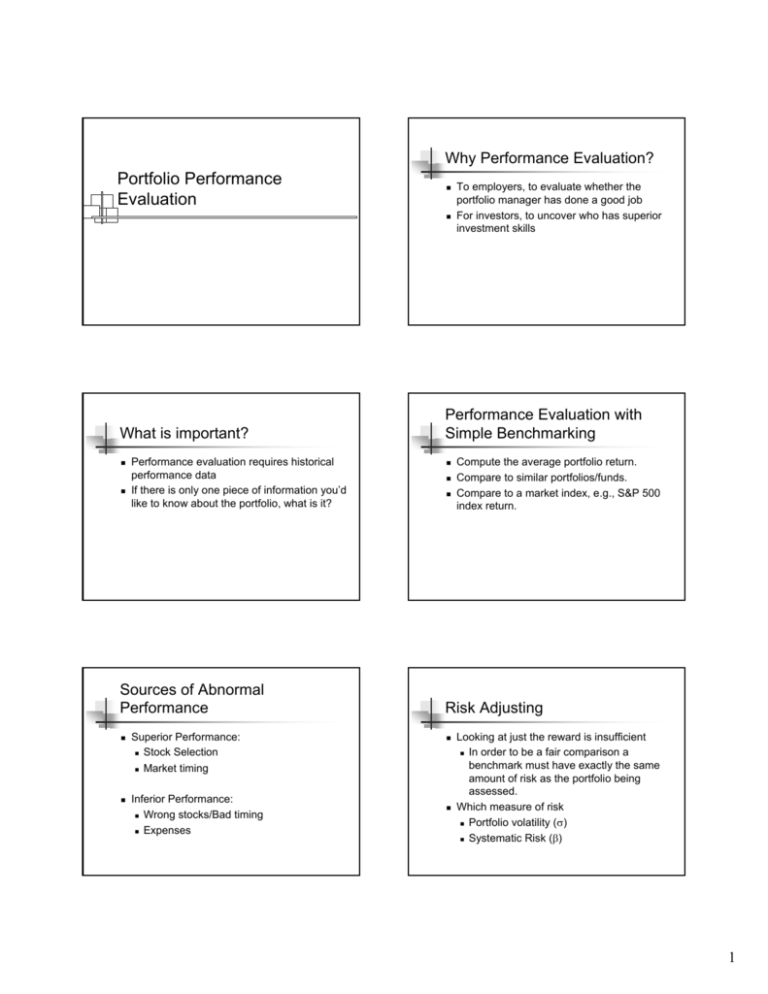Portfolio Performance Evaluation
advertisement

Why Performance Evaluation? Portfolio Performance Evaluation What is important? Performance evaluation requires historical performance data If there is only one piece of information you’d like to know about the portfolio, what is it? Sources of Abnormal Performance Superior Performance: Stock Selection Market timing Inferior Performance: Wrong stocks/Bad timing Expenses To employers, to evaluate whether the portfolio manager has done a good job For investors, to uncover who has superior investment skills Performance Evaluation with Simple Benchmarking Compute the average portfolio return. Compare to similar portfolios/funds. Compare to a market index, e.g., S&P 500 index return. Risk Adjusting Looking at just the reward is insufficient In order to be a fair comparison a benchmark must have exactly the same amount of risk as the portfolio being assessed. Which measure of risk Portfolio volatility (σ) Systematic Risk (β) 1 Security Characteristic Line CAPM One way to adjust for risk is to use CAPM Expected return (normal return) is a function of the portfolio’s beta ♦ Recall that we estimate the CAPM equation using OLS regression Ri = R f + β i (RM − R f ) + ei (R − R ) = β (R i f i M − R f ) + ei Y = α + βX + e ♦ where a is a constant (which the CAPM predicts should be zero) and ei is an error term which reflects firm-specific risk not being captured by beta. The Security Characteristic Line Security Characteristic Line Excess Return on Asset Distance from the line to the points are the error terms. The Security Characteristic Line Beta for the firm is the slope of this line. Jensen Alpha for the firm is the intercept of this line. The percentage of total variance being captured by beta is given by the R2 statistic of the regression. The standard deviation of the errors, σe , (also called the standard error of the regression) measures firm-specific risk not being captured by beta. Excess Return on Market An Example Monthly data from 1982-2001 Alpha Alpha t-stat Beta Beta t-stat σe Performance Measures IBM 0.0020 0.53 0.940 9.21 0.0700 GE 0.0050 1.83 1.150 19.51 0.0400 Sharpe ratio Treynor ratio Jensen’s alpha Appraisal ratio M2 R2 0.260 0.620 You can estimate the beta of a portfolio similarly. 2 Why so many measures? Each measures performance controlling for risk Measures of return Measures of risk How to adjust risk The choice of the most appropriate measure is generally dependent upon the circumstances involved. We will look at performance using this data: Mean Std Dev Rf 6% 0 Portfolio M 14% 16% Portfolio P 18% 20% M is the market portfolio. The beta of P is 1.125. The Sharpe Ratio Sharpe Ratio The Sharpe ratio measures excess return per unit of total risk. Sp = Example Slope of CAL Sp = E (rP ) − rf σp E (R p ) − R f σ p This measure is useful when the portfolio in question represents the entire risky investment. Treynor’s Measure The Treynor ratio measures excess return per unit of systematic risk. Tp = Treynor’s Measure E (R p ) − R f T= E (rP ) − rf βp βp This measure is useful when the portfolio in question represents one of several risky investments. 3 Jensen’s Alpha Jensen’s Alpha α p = (rp − rf ) − [β (rM − rf )] Jensen’s measure is the average return on the portfolio over and above that predicted by the CAPM, given the portfolio’s beta. α p = Rp − [Rf + β p (Rm − Rf )] Requires estimation of the SCL (to obtain alpha). Appraisal Ratio (Information Ratio) Jensen’s Alpha Return SML alpha M AR = 1.0 This measure is useful when the portfolio in question is an active portfolio mixed with the passive index portfolio. Beta M2 αp σe p rf The appraisal ratio divides the alpha of the portfolio by the nonsystematic risk of the portfolio. While the Sharpe ratio can be used to rank portfolio performance, its numerical value is not easy to interpret. Like the Sharpe ratio, the M2 focuses on total volatility as a measure of risk, but its riskadjusted measure has the easy interpretation of a differential return relative to a benchmark index. M2 Market portfolio is M, managed portfolio is P Step 1: compute the average return of M and P Compute the standard deviation of M and P 4 M2 Step 2: we form a mimicking portfolio comprised of P and T-bills which has the same standard deviation as a market index such as the S&P500. For example, if the managed portfolio has 1.5 times the standard deviation of the index, the mimicking portfolio would be two-thirds invested in P and one-third in Tbills. M2 Step 3: Compute the average return of the mimicking portfolio, P*. The mimicking portfolio has the same standard deviation as the index by design. Step 4: 2 The M measure is the difference between the expected return of the mimicking portfolio and the market portfolio M 2 = RP* − RM M2 Which Measure is Appropriate? It depends on investment assumptions 1) If the portfolio represents the entire investment for an individual, Sharpe ratio compared to the Sharpe ratio for the market. 2) If many alternatives are possible, use the Jensen α or the Treynor measure. 3) If you mix actively managed portfolios with passively managed portfolios, use Appraisal ratio. Market Timing Market timing involves shifting funds between a market index and a safe asset. When the market is up, the portfolio beta will be higher, because more funds are invested in the risky asset. When the market is down, the portfolio beta will be lower, because more funds are invested in the safe asset. Market Timing SCL: Beta increases with the market excess return Rp - Rf * * * * ** * * ** * * * * * * * ** * * ** R m - Rf 5 Market Timing This can be tested by adding a quadratic term in the SCL regression. If the coefficient on squared market excess returns is significant, then timing ability exists. Treynor and Mazuy (1966) found no evidence of timing ability. Henriksson (1984) tested 116 funds and found little evidence of timing ability. Most funds had negative point estimates of timing ability. Luck or Skill Market Timing rP − rf = a + b(rM − r f ) + c(rM − r f ) + eP 2 When he gets a low return, it could be Peter Lynch’s score card at Magellan: Start in 1977 with $20 million end in 1990 with $14 billion Average 29.2% annualized return (versus 15.8% for the S&P 500 index) Beat S&P 500 11 out of 13 years Is Peter Lynch skilled? Estimate the above regression, if c is statistically greater than 0, then we conclude the portfolio manager has market timing ability. Luck or Skill Financial returns are uncertain When a portfolio manager achieve a high return, it could be Luck or Skill Treynor and Mazuy How do distinguish luck and skill? There are two portfolio managers, A and B. A and B both have an average excess return of 10% over the past three years The excess returns of A are 10%, 5%, 15% The excess returns of B are -10%, 40%, 0% Who is more likely to be skilled? Luck or Skill Alternatively, is Peter Lynch simply lucky? Can a monkey beat Peter Lynch? What is the monkey’s chance to accumulate such a record (beat S&P 500 index 11 out of 13 years) ⎛13 ⎞ 13! ⎜⎜ ⎟⎟(0.5)13 = (0.5)13 = 0.00952 11 11 ! 2 ! ⎝ ⎠ 6 Luck or Skill So a monkey would have 0.952% chance to achieve Peter Lynch’s record One out 105 monkeys could have done it There are approximately 5000 equity funds today We should take the magnitude the outperformance into account as well In general, it is difficult to tell who is skilled 7









